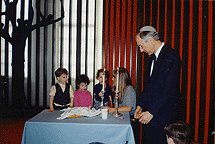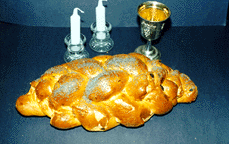

Shabbat is the beloved day of rest that begins Friday night at sundown and lasts until Saturday at sundown. In observing Shabbat the Jewish people are following the Torah by working six days a week and resting on the seventh.
The Jewish family begins its Sabbath preparations early Friday afternoon by cleaning and tidying up the home and preparing the Friday night Shabbat meal. Strictly observant Jews prepare and cook all the meals in advance of Shabbat for they do not do any work nor turn on any electricity during the rest period.

The erev Shabbat meal is like
a ceremony in itself. The woman of the home will begin by lighting
the Shabbat candles. There are at least two candles lit, one reminds
us to remember the Shabbat and the second reminds us to honour
the Shabbat, the two versions of the fourth commandment. Next
the man of the home will make kiddush over the wine. On Shabbat
the wine is drunk from a special wine goblet called a Kiddush Cup.
Finally a motzi is made over the challah bread. What is
eaten as the main meal varies from home to home based on their
own familial traditions. Some families eat chicken while others
eat fish. Meal time is an opportunity for family and friends to
enjoy a leisurely dinner and each others company. Depending on
the stream of Judaism, people might go
to synagogue before or after dinner. Saturday during the day Jewish
people who observe Shabbat refrain from doing any work or shopping.
As such Jewish families often return to synagogue, on Saturday
morning for the Shabbat reading of Torah. Saturday is a day to
read and rest. Shabbat is a perfect opportunity to reflect on
the past week and look to the week ahead.
 In keeping with the special qualities of Shabbat, its ending merits
a farewell service, called Havdalah. A glass of wine, a braided
havdalah candle and a spice box filled with sweet smelling spices
are three key symbols of the Havdalah service. Wine gladdens the
heart and helps us overcome the misery and pain that taints our
world. A braided candle with at least two wicks is used in the
Havdalah service, since the Talmud says
it should be like a torch. The significance behind more than one
wick is to remind us that all qualities come in pairs. For example,
fire can be beautiful and helpful for warmth while at the same
time can be very hurtful and dangerous. The actual lighting of the candle is also the first labour of
work since the time of rest.
In keeping with the special qualities of Shabbat, its ending merits
a farewell service, called Havdalah. A glass of wine, a braided
havdalah candle and a spice box filled with sweet smelling spices
are three key symbols of the Havdalah service. Wine gladdens the
heart and helps us overcome the misery and pain that taints our
world. A braided candle with at least two wicks is used in the
Havdalah service, since the Talmud says
it should be like a torch. The significance behind more than one
wick is to remind us that all qualities come in pairs. For example,
fire can be beautiful and helpful for warmth while at the same
time can be very hurtful and dangerous. The actual lighting of the candle is also the first labour of
work since the time of rest.
 Finally there is the spice box (tower)
whose sweet smell consoles us on the passing of Shabbat. When
the sun is setting and Shabbat is almost over, one says a special
prayer over the a glass of wine and each participant takes a ceremonial
sip from the goblet. Subsequent rituals are made over the candle
and spices. One lights the candle and holds the flame near their
nails so as to see the glow/beauty of the Shabbat light. A prayer is made over
the spice box and each participant in the
service will smell the spices. Once the rituals are completed,
we say goodbye to Shabbat by extinguishing the candle into the
wine cup, and sing a song praying for a good new week. Shabbat
is now over and once again we begin our week of work.
Finally there is the spice box (tower)
whose sweet smell consoles us on the passing of Shabbat. When
the sun is setting and Shabbat is almost over, one says a special
prayer over the a glass of wine and each participant takes a ceremonial
sip from the goblet. Subsequent rituals are made over the candle
and spices. One lights the candle and holds the flame near their
nails so as to see the glow/beauty of the Shabbat light. A prayer is made over
the spice box and each participant in the
service will smell the spices. Once the rituals are completed,
we say goodbye to Shabbat by extinguishing the candle into the
wine cup, and sing a song praying for a good new week. Shabbat
is now over and once again we begin our week of work.
| Holidays | Glossary | Treasures | Life Cycle | Home Page |